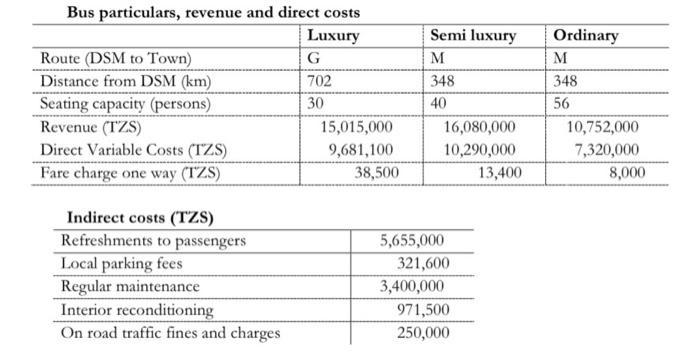Question
TESLA is a licensed transport operator in Tanzania providing passenger transport services from Dar es Salaam to two different towns in Tanzania. The operator owns
TESLA is a licensed transport operator in Tanzania providing passenger transport services from Dar es Salaam to two different towns in Tanzania. The operator owns buses of two different classes which are almost of the same type, by make, but provide slightly different levels of comfort to passengers by way of design and on board services. In March 2017, TESLA introduced another class of buses which the operator started to use in the first and second week of June 2017. Information in the following tables is for that particular fortnight.

All buses pay parking fees once on departure. No parking fee is paid on arrival or at any other local station en-route. Every passenger pays full fares regardless of his/her destination. Buses depart when they are at full capacity and that any passenger who boards on the way his/her fare is not remitted.
On every arrival, buses go for reconditioning to ensure that new passengers enjoy tidy interior
condition. Each passenger in an ordinary bus gets refreshments equivalent to half the portion that a passenger in other classes of buses get while on board. Buses have to undergo a minor regular maintenance, which costs the same for every bus, after travelling about 700 km. At the moment TESLA has no any other source of revenue apart from bus fare received from passengers. Every passenger is presumably charged a markup of 20%.
Required
Using ABC approach, assuming that none of passenger boarded on the way,
i)Estimate overhead allocation rate for each cost pool.
ii)Estimate TOTAL overhead cost of each passenger.
iii)The company adds a markup of 20% for profit. Comment on fares charged on different categories of customers' for each class of busses.
Bus particulars, revenue and direct costs Luxury Route (DSM to Town) Distance from DSM (km) Seating capacity (persons) Revenue (TZS) Direct Variable Costs (TZS) Fare charge one way (TZS) Indirect costs (TZS) Refreshments to passengers Local parking fees Regular maintenance Interior reconditioning On road traffic fines and charges G 702 30 15,015,000 9,681,100 38,500 Semi luxury M 348 40 16,080,000 10,290,000 5,655,000 321,600 3,400,000 971,500 250,000 13,400 Ordinary M 348 56 10,752,000 7,320,000 8,000
Step by Step Solution
3.55 Rating (155 Votes )
There are 3 Steps involved in it
Step: 1

Get Instant Access to Expert-Tailored Solutions
See step-by-step solutions with expert insights and AI powered tools for academic success
Step: 2

Step: 3

Ace Your Homework with AI
Get the answers you need in no time with our AI-driven, step-by-step assistance
Get Started


